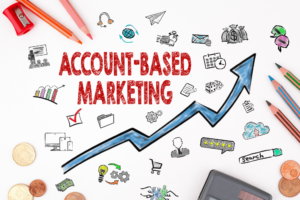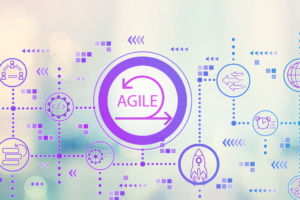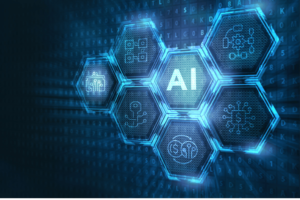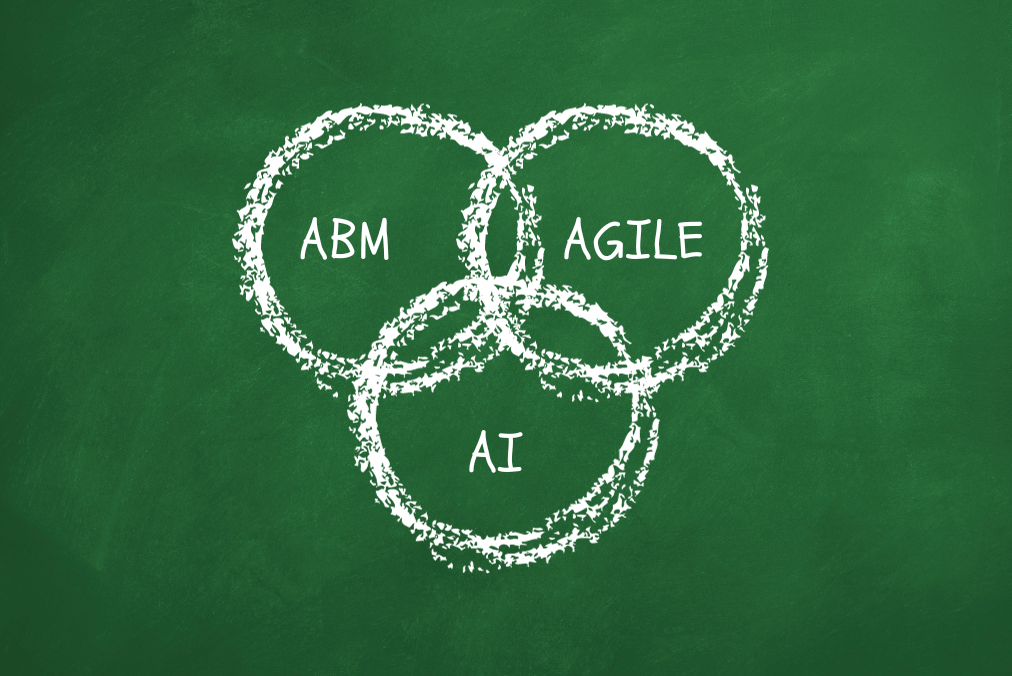In the ever-evolving landscape of digital marketing, staying ahead of the curve is imperative. The convergence of Account-Based Marketing (ABM), Agile Marketing, and Artificial Intelligence (AI) has emerged as a game-changer, revolutionizing the way businesses approach their marketing strategies. In this article, we’ll delve deeper into this marketing revolution and envision what the future holds.
ABM: The Cornerstone of Precision
Account-Based Marketing (ABM) isn’t a new concept, but its resurgence is remarkable. It’s a strategic approach that focuses on treating each prospect or customer as an individual market. This personalization is poised to redefine marketing strategies in profound ways.

The concept of ABM is elegantly simple: Instead of casting a wide net and hoping to catch a variety of fish, you’re using a targeted, precision-focused strategy to catch the specific fish you want. In this analogy, each fish represents a high-value account or prospect.
Imagine you run a company that sells premium software to large enterprises. In a traditional marketing approach, you might create generic content, distribute it broadly, and hope that some large enterprises take interest. ABM, on the other hand, takes a different approach. You identify a list of high-value enterprise accounts you want to target, gather detailed information about them, and then craft personalized marketing campaigns and messages tailored specifically to their needs, pain points, and goals.
Future Insight: In the not-so-distant future, ABM will be powered by hyper-personalization. AI algorithms will analyse extensive datasets to craft laser-focused campaigns that speak directly to the unique needs and pain points of individual accounts. This level of personalization will deepen customer engagement and drive higher conversion rates.
Agile Marketing: A Symphony of Collaboration
Agile Marketing is a methodology borrowed from software development that emphasizes adaptability, collaboration, and customer feedback. In the context of ABM, Agile Marketing allows marketing teams to iterate quickly, adjust strategies based on real-time data, and respond to changing market conditions.
 At its core, Agile Marketing is about doing more with less. It’s about being flexible and efficient. It’s about finding the most effective way to achieve your marketing goals and adapting to change as it happens. Here’s how Agile Marketing fits into the equation:
At its core, Agile Marketing is about doing more with less. It’s about being flexible and efficient. It’s about finding the most effective way to achieve your marketing goals and adapting to change as it happens. Here’s how Agile Marketing fits into the equation:
- Sprints and Iterations: Agile Marketing divides tasks into short, focused sprints. Each sprint has a specific goal and timeframe, which helps teams stay on track and deliver results. This approach is especially useful when running ABM campaigns because it allows you to quickly adapt to shifts in account behaviour or market conditions.
- Cross-Functional Collaboration: Agile Marketing encourages close collaboration between marketing, sales, and other departments. This alignment is crucial for ABM, where marketing and sales teams need to be in sync. In the future, we can expect even deeper collaboration, with marketing, sales, and product development teams working together as dynamic units to create seamless customer experiences.
- Data-Driven Decision-Making: Agile Marketing relies on data to make informed decisions. AI plays a pivotal role here by providing insights into customer behaviour, helping teams refine their strategies. As AI continues to advance, we can anticipate more sophisticated data analysis, predictive modelling, and real-time recommendations, further enhancing Agile Marketing’s capabilities.
Supercharging with AI
Artificial Intelligence (AI) is the secret sauce that takes ABM and Agile Marketing to the next level. Its capabilities are boundless, and it’s already changing the game in profound ways.

- Predictive Analytics: AI-powered predictive analytics can identify potential high-value accounts by analysing historical data and spotting patterns. This allows marketers to prioritize their efforts effectively. For example, AI can analyse past customer behaviour to predict which accounts are most likely to convert and deserve special attention.
- Personalization at Scale: AI-driven personalization can tailor content and messaging for individual accounts, ensuring that each interaction feels highly relevant and engaging. Imagine receiving an email from a company, and every aspect of that email – from the subject line to the body content – is uniquely crafted just for you based on your preferences and past interactions with the brand. AI makes this level of personalization achievable at scale.
- Chatbots and Automation: AI-driven chatbots can engage prospects in real-time, answering questions and providing information. This accelerates the sales cycle and frees up valuable human resources. These chatbots will evolve, becoming more sophisticated in understanding and responding to customer emotions, delivering personalized recommendations, and even providing emotional support.
- Behavioural Insights: AI can analyse customer behaviour across multiple touchpoints, providing valuable insights for ongoing campaign optimization. This means AI can not only identify patterns and trends but also adapt marketing strategies in real-time based on customer behaviour. For example, if AI detects that a customer is showing signs of interest in a product, it can trigger a personalized follow-up message or offer.
The Future Landscape: A Vision
Picture this: In the future, marketers will have at their disposal an AI-driven dashboard that’s like a crystal ball. This dashboard not only predicts market shifts but also recommends personalized content strategies and suggests the optimal moment to engage with a prospect. This dashboard will be an indispensable tool for marketing teams, helping them make data-driven decisions and stay ahead of the competition.
Sales and marketing teams will no longer operate in silos. They will form an agile, united front, collaborating seamlessly to deliver unified brand experiences. Marketing strategies will evolve organically, responding in real-time to customer feedback and market dynamics. The boundaries between marketing and sales will blur as both teams work together to nurture leads and close deals.
But what about the customer perspective in this future landscape? Customers won’t just be passive recipients of marketing messages. They will become active participants, co-creating brand narratives. Imagine interacting with a brand where your feedback not only shapes the products and services but also the marketing campaigns themselves. AI-driven customer feedback analysis will play a pivotal role here, helping brands understand customer sentiments and preferences on a granular level.
Furthermore, chatbots will evolve into virtual companions, providing information, assistance, and emotional support. They will be able to understand and empathize with customers’ feelings, whether they’re excited about a new product release or frustrated with a service issue. The future of marketing will be characterized by emotionally intelligent AI that enhances the overall customer experience.
In this future, the lines between marketing and customer experience will blur, and marketing will transcend the realm of promotion to become a strategic driver of overall business growth. Customer-centricity will be at the core of every marketing strategy, with AI helping to deliver personalized and memorable experiences.
Conclusion: Embrace the Future Now
The convergence of ABM, Agile Marketing, and AI is a harbinger of a new era in marketing. It’s a journey into the future where precision, adaptability, and data-driven insights will define success. Those who embrace this revolution today will be the pioneers shaping the marketing landscape of tomorrow. The future of marketing is here—don’t be a spectator; be a part of the transformation.
In conclusion, the combination of ABM, Agile Marketing, and AI is redefining the way we approach marketing. It’s not just a technological revolution but a cultural shift in how marketing teams operate. Embracing these changes and staying agile in the face of evolving consumer behaviour and technology is the key to staying competitive in the modern marketing landscape. The future promises even more exciting developments, and the marketers who are prepared to adapt and innovate will thrive in this ever-changing environment.

